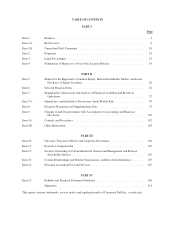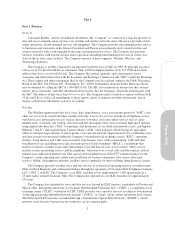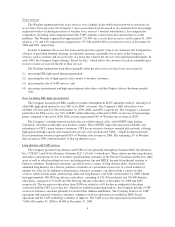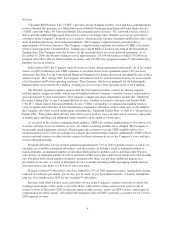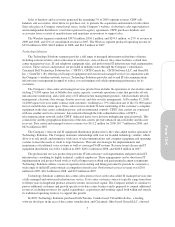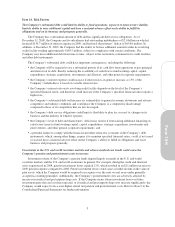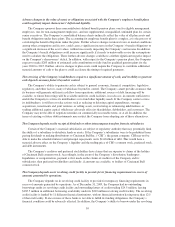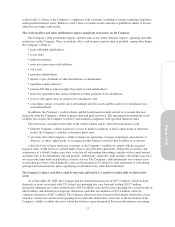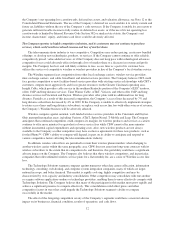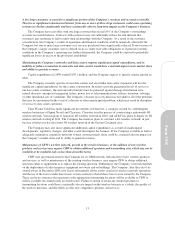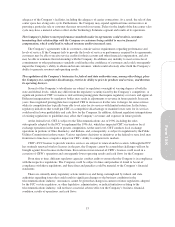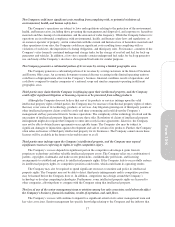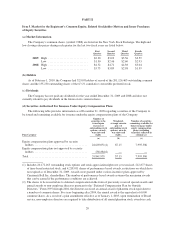Cincinnati Bell 2009 Annual Report Download - page 80
Download and view the complete annual report
Please find page 80 of the 2009 Cincinnati Bell annual report below. You can navigate through the pages in the report by either clicking on the pages listed below, or by using the keyword search tool below to find specific information within the annual report.Adverse changes in the value of assets or obligations associated with the Company’s employee benefit plans
could negatively impact shareowners’ deficit and liquidity.
The Company sponsors three noncontributory defined benefit pension plans: one for eligible management
employees, one for non-management employees, and one supplemental, nonqualified, unfunded plan for certain
senior executives. The Company’s consolidated balance sheets indirectly reflect the value of all plan assets and
benefit obligations under these plans. The accounting for employee benefit plans is complex, as is the process of
calculating the benefit obligations under the plans. Further adverse changes in interest rates or market conditions,
among other assumptions and factors, could cause a significant increase in the Company’s benefit obligations or
a significant decrease of the asset values, without necessarily impacting the Company’s net income. In addition,
the Company’s benefit obligations could increase significantly if it needs to unfavorably revise the assumptions
used to calculate the obligations. These further adverse changes could have a further significant negative impact
on the Company’s shareowners’ deficit. In addition, with respect to the Company’s pension plans, the Company
expects to make $203 million of estimated cash contributions to fully fund its qualified pension plans for the
years 2010 to 2017. Further, adverse changes to plan assets could require the Company to contribute additional
material amounts of cash to the plan or could accelerate the timing of required payments.
The servicing of the Company’s indebtedness requires a significant amount of cash, and its ability to generate
cash depends on many factors beyond its control.
The Company’s ability to generate cash is subject to general economic, financial, competitive, legislative,
regulatory, and other factors, many of which are beyond its control. The Company cannot provide assurance that
its business will generate sufficient cash flow from operations, additional sources of debt financing will be
available, or future borrowings will be available under its credit facilities, in each case, in amounts sufficient to
enable the Company to service its indebtedness or to fund other liquidity needs. If the Company cannot service
its indebtedness, it will have to take actions such as reducing or delaying capital expenditures, strategic
acquisitions, investments and joint ventures, or selling assets, restructuring or refinancing indebtedness, or
seeking additional equity capital, which may adversely affect its shareholders, debtholders, and customers. The
Company may not be able to negotiate remedies on commercially reasonable terms, or at all. In addition, the
terms of existing or future debt instruments may restrict the Company from adopting any of these alternatives.
The Company depends on the receipt of dividends or other intercompany transfers from its subsidiaries.
Certain of the Company’s material subsidiaries are subject to regulatory authority that may potentially limit
the ability of a subsidiary to distribute funds or assets. If the Company’s subsidiaries were to be prohibited from
paying dividends or making distributions to Cincinnati Bell Inc. (“CBI”), the parent company, CBI may not be
able to make the scheduled interest and principal repayments on its $1.6 billion of debt. This would have a
material adverse effect on the Company’s liquidity and the trading price of CBI’s common stock, preferred stock,
and debt instruments.
The Company’s creditors and preferred stockholders have claims that are superior to claims of the holders
of Cincinnati Bell common stock. Accordingly, in the event of the Company’s dissolution, bankruptcy,
liquidation, or reorganization, payment is first made on the claims of creditors of the Company and its
subsidiaries, then preferred stockholders and finally, if amounts are available, to holders of Cincinnati Bell
common stock.
The Company depends on its revolving credit facility to provide for its financing requirements in excess of
amounts generated by operations.
The Company depends on its revolving credit facility to provide for temporary financing requirements in
excess of amounts generated by operations. As of December 31, 2009, the Company had no outstanding
borrowings under its revolving credit facility and outstanding letters of credit totaling $24.5 million, leaving
$185.5 million in additional borrowing availability under its $210 million revolving credit facility. The revolving
credit facility is funded by 11 different financial institutions, with no financial institution having more than 12%
of the total facility. If one or more of these banks is not able to fulfill its funding obligations, the Company’s
financial condition could be adversely affected. In addition, the Company’s ability to borrow under the revolving
10




